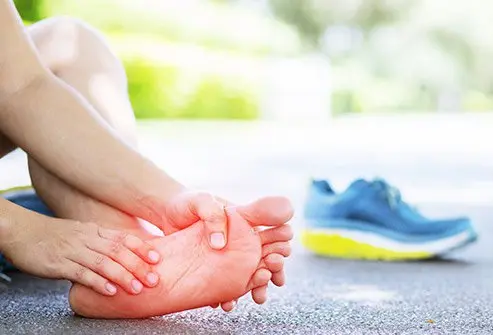Table of contents
Real Relief: What Actually Works for Foot Pain
Key Takeaways
● Foot pain often stems from issues beyond the feet, such as tight calves, weak arches, or poor posture.
● Effective pain relief for feet includes strengthening exercises, mobility drills, and addressing overall body mechanics.
● Over-reliance on quick fixes like insoles or painkillers may provide temporary relief but won’t solve underlying problems.
● Customized approaches, like those offered at Beometry, focus on identifying and treatin the root causes of foot pain for long-term relief.
Your feet carry the weight of your world, literally. Whether you’re a runner, a lifter, or someone just trying to make it through the workday, foot pain can hit hard and throw everything off. Pain in your feet doesn’t always come from just your feet. Tight calves, hip imbalances, poor core control, or even the way you breathe can all mess with how your feet feel.
So, if you’ve tried the usual pain relief for feet, ice packs, foot rubs, or a quick massage, and still feel that dull ache or sharp sting, it’s time to look deeper.
Why Foot Pain Keeps Coming Back
Quick fixes may take the edge off, but they don’t always get to the root cause. At Beometry, we see foot pain not just as a problem to numb but as a signal. Your body’s way of saying, “Hey, something’s not working right.”
Here’s what might really be going on:
● Poor ankle mobility
● Weak or underused foot muscles
● Tight calves or hamstrings
● Pelvic misalignment or instability
● Collapsed arches
When these areas are off, your feet often take the hit. That’s why long-term pain relief for feet usually involves more than just what you put on or under them.
Common Culprits Behind Foot Pain
From heel pain to burning arches, here are some usual suspects, and why quick fixes often don’t cut it:
● Plantar Fasciitis: That sharp heel pain in the morning? It’s not just about your heel. It often ties back to tight calves, weak glutes, or even how you breathe during movement.
● Flat Feet/Collapsed Arches: Lack of foot control and strength, combined with poor pelvic positioning, often causes this.
● Overpronation: When your foot rolls in too much, it can be a sign of weak hip stabilizers or poor coordination through the core.
● High Arches: On the flip side, this can limit shock absorption and increase impact through the heel and forefoot.
You don’t need to be an athlete to deal with these issues. Standing all day, wearing unsupportive shoes, or simply being in pain after a long walk are all reasons to take foot pain seriously.
Best Practices for Foot Pain Relief That Actually Work
There’s no single best foot pain relief trick that works for everyone. But here’s what we often look at:
| Strategy | Why It Helps |
| Foot strengthening | Builds control, improves shock absorption, and supports arch structure. |
| Pelvic floor training | Affects alignment all the way down to your feet. Helpful especially if you’re dealing with foot and leg pain relief. |
| Calf mobility work | Frees up ankle range and reduces pressure on the heel and arch. |
| Slow motion strength training | Builds awareness and muscle control to improve your gait and stance. |
| Breathing drills | Reduces tension patterns and improves core-foot coordination. |
| Soft tissue work | Can help with relief from foot pain in the short term while building long-term function. |
Looking for targeted relief of foot pain that lasts? Start by understanding your movement and posture habits
What About Products and Tablets?
When it comes to over the counter foot pain relief, things like foot pain relief tablets or topical creams may help temporarily. But they won’t fix muscle imbalances, poor gait mechanics, or weak arches. That’s why they work better as part of a complete plan, not a standalone fix.
If you’re overweight or dealing with chronic foot issues, the best relief for foot pain often includes addressing alignment, breathing patterns, and overall movement efficiency, not just the feet. In that case, check out our online fitness and nutrition coaching to learn how we tailor programs that address pain at the source.
Get to the Root for Lasting Relief
You deserve more than just temporary fixes. The best pain relief for foot pain comes from building a body that moves well, not just masking symptoms. We don’t just look at your feet, we look at how your entire body is working together (or not).
Need help figuring out what your feet are trying to tell you? Book a free consultation with Beometry and let’s break it down together. We’ll look at how your breath, movement, and alignment are affecting everything from your toes to your hips.


